One of the first things Uncle Simil Johnson, a proud Tanna man, the chair of the Vanuatu Provincial Fund and the country’s Director of Statistics, says as he picks me up from the Port Vila airport is this: ‘People here they don’t look like they have problems. They get on with their lives. But inside, they are hurting.”
It would be a comment he’d repeat to me in various ways over the course of my first two days in the cyclone-ravaged Vanuatu, the small nation of 83 islands that was crowned, not once, but twice, the ‘happiest place on earth’.
And it’s true: despite the destruction around them, the ni-Vanuatu still seem happy. They hide their hurt inside their shattered villages, concealing what they can in a land where there are now no leaves on the bounty of trees.
Uncle Simil tells me as we sit later on the grass outside the Tanna airport, “It must have been a big animal to have eaten them all.”
A week ago, the category 5 Tropical Cyclone Pam ripped through the islands, its path barrelling straight for the capital Port Vila, on the island of Efate. It also struck the outer islands of Tanna and Erromango, where its destructive force was most harsh.
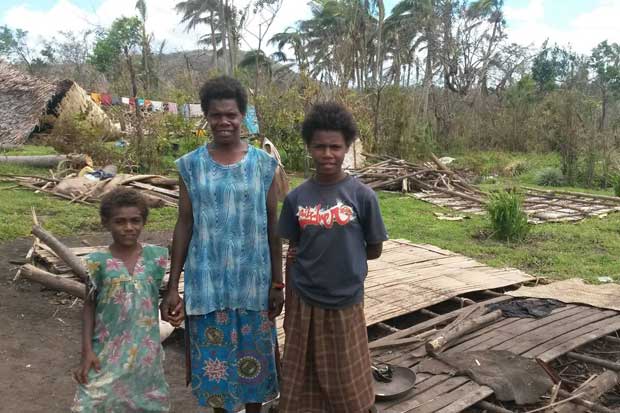
For locals, so used to hearing ‘where’s Vanuatu?’, the tiny island nation became, for one week, the worry of the world. Everyone I spoke to on Tanna said they had never seen anything like it.
The official death toll throughout Vanuatu is 16, according to the United Nations. On Tanna, there was an estimated figure of eight. But you can’t equate the sheer enormity of this cyclone through numbers. It does not illustrate the images of destroyed houses, wrecked landscape, and the destruction of the majority of crops throughout the island.
The food that has already been harvested will rot within weeks, leaving the people of Tanna entirely reliant on aid.
Tanna is a homeland of sorts to me – on the black sands of the beach next to Lenakel, the main centre on the Island my great, great grandfather was stolen, tricked into a ship with the promise of toys (he was only in his mid-teens) and sent to Queensland to work in the sugar cane fields in another of Australia’s suppressed black history of slavery.
He left behind a twin, and Simil Johnson and his family is directly descended from him. Although Simil lives in Port Vila, the majority of his brothers and sisters live in that same village from where my great, great grandfather was taken – Lamlaklak, part of the wider Lomtehekel, a village a top the mountain and one of the main 11 Nakamals, or meeting places, on Tanna.
I first visited when I was aged nine, and have been back several times over the years. There was a big custom ceremony on that first trip and my sister and I were given custom names.
My name is Tohou Lidia and my sister is Narlin Selina. We have namesakes in the village – several Tohous and Narlins.
But this trip was not just to report on the Cyclone, but also to check up on the family who has welcomed us back to our ancestral land and wants us to come home.
I’m sick with worry. Even Uncle Simil hadn’t received word from his family, or his daughter Amelia, my namesake – another Tohou.
The cyclone thrust Tanna into a black zone, there were no mobile communications or power. People learn by swapping message upon message, a sophisticated Chinese Whispers with a higher level of reliability. The story of two deaths – an old and younger woman – was recounted to me with a great level of detail and collaborating accuracy in two separate villages.
The younger woman had gone into a building to retrieve the lady and two big blocks had fallen on top of them. They were buried the day after the storm, even as the rain was falling into their graves.
But they have not been waiting for help. The people of Tanna began rebuilding their lives – and their homes – the very next day.
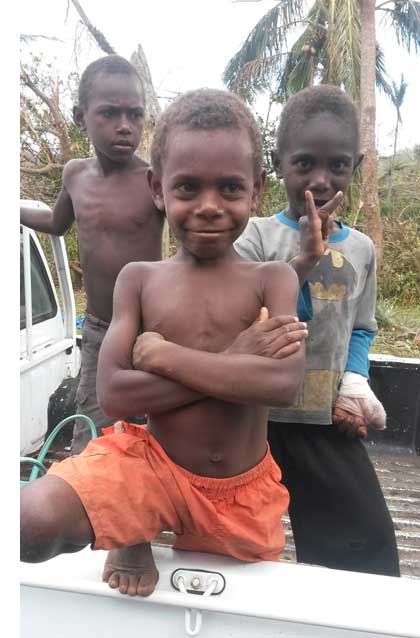
LENAKEL, Tanna’s main centre, is Black Man’s Town.
On Saturday, exactly a week after Cyclone Pam tore through the island, ripping up trees, plants, gardens and lives, Black Man’s Town is characteristically buzzing with activity. Except instead of the fruit and vegetable markets, and the splattering of tourists bedecked in braids, there are streams of aid workers hanging out of the back trays of utes.
As Uncle Simil loads up on the ute with eight big bags of rice to take to the village, World Vision turns up. Across the road is Samaritan’s Purse. The Red Cross walks into the same store and behind them a solitary Lions worker. Aid group based here are adorned in French writing (before independence in 1983, Vanuatu was ruled jointly by the British and French, in a consortium government).
The aid workers proclaim their employer’s brands with ferocity, as if to ensure they are not lost amongst the ruin.
But while the aid workers and army are welcome in Tanna, to tell their story first, would be to miss the strength of the Tanna people themselves. Because as you drive through Lenakel and the rest of Tanna, you see a different story than one of devastation that lit up the international headlines.
Tanna men are already on decapitated roofs, hammering in metal sheets and salvaging the shops in Black Man’s Town. You can see women within the villages already weaving the roofs for their grass huts. People crowd around amidst the ruined foliage of their homes, re-building cement structures brick upon brick.
We pick up Dickson from this village. He has flown in from Port Vila and has brought with him two chain saws. He plans to stay. Locals wait patiently as the Vanuatu Ferry delivering much needed supplies zooms in from a dot on the horizon, to the black sand shore of that same beach that sealed my great, great grandfather’s fate.
“This is very big, but you may not see it in their lives,” Uncle Simil tells me. “They have that inside their feelings. But to change that situation now, they have to move forward and that’s what they are doing.
“If you look at Vila, there is damage, but they are moving directions to take their life back.
“Rather than wait for two or three years, or a few months, during the early morning after the cyclone, the wind was still blowing and you can see hammers on the roofs.”
As we drive into Simil’s village, I prepare myself for the devastation of the village of my ancestors. We chug slowly up the steep hill, and can see where people used to garden.
The black mounds which contained the manioc and kumala on the sides of the hills are empty, stripped from the force of the winds. We see occasional remnants of sandlewood trees – another income stolen by the storm.
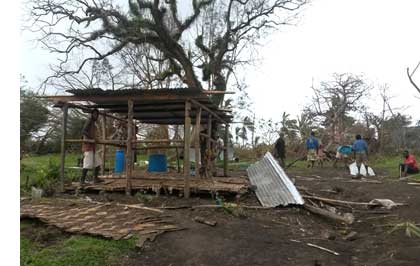
We drive past a destroyed school and continue, passing the soccer field that always heralds Lomtehekel. When I see this field, I know we are there. There are children, their faces I remember, on the side of the road eating plain rice on plates. Their inquisitive gazes light up when they see who is in the car “Uncle Simil! Uncle Simil!” they proclaim.
I see my namesake’s daughter – Laura. She is in year 8 at school but will not return for at least three months because the buildings are destroyed.
As we pull into the Nakamal, the devastation is immense. The usually tidy meeting place is full of dead branches and trees. The huts where men drink kava are collapsed and the old men sit in their destroyed shelter.
The chief is sitting on the branches of one of the two big Banyan trees.
Out runs Simil’s mother – we call her Mama. She is small in stature but has always been, and still is, one of the strongest people I know. She approaches and embraces us.
Across the Nakamal runs my namesake Tohou. I meet uncles and aunties and happy children who grab my hands and pull as if I’m a doll.
Everything is the same except for that cyclone, now gone but still present, like the black sheep of the family, in their lives.
Everyone is safe, although Uncle Simil’s aunty was sick and had to be airlifted to Vila. That is one bitter blessing.
I AM sitting in a nimalten with Wasikam Johnson, the wife of Uncle Simil’s youngest brother Oleman, and Laura. The nimalten is traditionally used to house the old people, and was built in Lamalakluk last November. Made of pandanus leaves, it is almost triangular, like a tent, and supported by wooden beams. They used to tie it with ropes but now they use nails.
“It is stronger. Better than any other house,” Wasikam says.
During the cyclone, everyone from nearby villages ran to Lamalaklak – almost 30 people in the nimalten, another 30 in a tin house and another 30 in the cement home built by Uncle Simil.
These were the only three structures in the surrounding villages capable of riding out the storm.
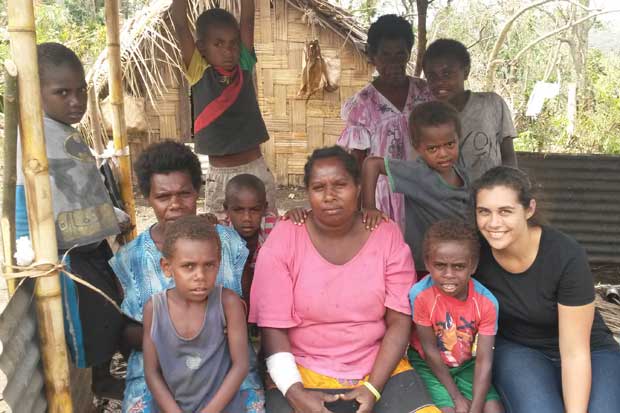
Wasikam tells me that they suspended cement blocks with rope in the middle beams of the nimalten, to stop it from collapsing. The children sat in the middle and the adults held up the structures with their hands, while the winds shook it violently.
“If we didn’t, it would go,” Wasikam tells me. “It looked like it would fall down any time.
“The house scared us. We were all frightened. On the day we were crying. But if this house was not here, maybe we would die. This house saved us.”
She says they weren’t given much warning. They have no radio in the village, and people drove by in trucks carrying messages. Two of them passed by Lomtehekel.
Her husband Oleman, tells me later that it was lucky the cyclone hit during the day. If it had hit at night, a lot more would have died.
I go and visit my namesake Tohou’s house. She had three structures. The men are busy constructing another house when I arrive, and there are several ladies sitting on the ground, weaving leaves for the roof and sides.
I photograph Tohou alongside one of the ruins of homes. It is completely flattened. But then she shows me the structure they built for her using the recycled materials they found lying in the debris. They built it within a day.
I am fed twice while I’m in the village. The first is a big plate full of manioc inside Tohou’s new house, as rain falls outside. It is the first rain since the cyclone. I want to refuse but they have the harvest for a few weeks until the vegetables go rotten. There is barely any fruit, although children walk around sucking on sugar cane, like they did before. The other meal is given to me by Mama – hard, chewy chicken, kamala and manioc.
Wasikam tells me her village needs more help. A lot of the clothing was destroyed, and there will shortly be a water crisis. They can’t go to the stream, which my great, great grandfather used to drink from, because the path is covered in debris, and even then it is contaminated from the storm.
The rain tank which adjoins the cement house, built by Uncle Simil, only has 20 litres left until the next rain.
And the food crisis looms, although people don’t show their worry.
Before I left Vila, SBS journalist Stefan Armbruster told me that the Vanuatu government (below right) is anticipating severe food shortages – up to 160,000 people could be left without food by Wednesday, and the aid being shipped in is barely enough. It could be so devastating that there could be food riots.
He is the only journalist who has reported this alarming fact.
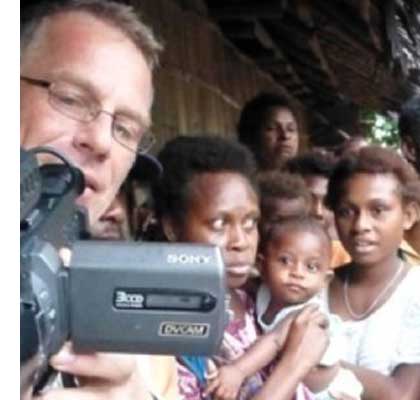
I ask Wasikam whether she is worried about aid. She says people don’t expect it. They have lived this long without it. They are used to being self-sufficient. But they still need help.
I ask Uncle Simil about whether he is worried about the food shortages. He says while aid is welcome, people should not expect it to be enough.
“They don’t want to reveal the difficulties they face,” he says. “What they want to do is move on with their life, in particular with the aid.
“This aid is coming, but I sit with them to tell them that aid is for the short term. The first time when this strikes, they didn’t expect the food to come. Of course, they will need assistance, but it’s only a temporary measure.”
Before I left for Vanuatu, my sister and I spent that night buying as many supplies we could, and packing them in four big suitcases. Air Vanuatu and Qantas waived $500 in excess baggage fees for me.
I help Wasikam unpack some of what I brought, which seems to me so sadly insufficient. We divide the meagre rations into 10 separate piles for different aunties. But she says thank you – this is the first aid they have received. They hadn’t seen any aid workers or government officials come into Lomtehekel.
Uncle Simil says, “I don’t think this will continue for a long time, the aid coming in. So that’s one thing they have in mind already. This is a short-term measure. We have to move on.
“They don’t have full confidence in the aid. They know the share they will get will not be enough for the family. They don’t want to wait for that.
“Somebody in the desert will try any way to survive, and these people are doing that.”
He says that relatives in Vila will help people on Tanna.
“We will survive. Whatever happens, we’ll try every way. I can go without anything to give food to my parents, to make sure they have food on the table. Until they are back in their normal life.
“That’s what many of us in Vila are already planning.”
Later we visit Amelia, my other namesake. She lives with her husband in his village and has a one-year-old son, Milson. She is worried about him.
“I’m finding it hard to find food here. All the crops were destroyed,” she tells me.
“I’m worried about Milson – we used our last money on diapers.”
Before the Cyclone, when you sat in her village, you could barely see anything past the trees. Now it is bare, and you can see the French ship on the horizon coming in.
We take a walk to the garden where the manioc is planted – there is none left. Her family picks at the remnants, and pulls out stalks of peanuts. There is nothing else. The fruit is gone.
We walk to her local church where Pastor Samuel is hammering away in the shadow of his church; the roof has been ripped apart. Near him is a concrete base where his home used to be. His family is living in a makeshift tin shack.
Amelia tells me the pastor’s family were huddled behind the pulpit of the church when the cyclone hit. As the roof collapsed around them they sheltered on the church stage. A couple of years ago I visited that church – their harmonious voices lifting up the Sunday and carrying the words of gospel songs throughout the villages.
During the cyclone, the family held hands in a single line, their backs pressed against the wall as they evacuated their church and ran to another grass hut behind them. It, thankfully, is still standing.
Amelia tells me the cyclone was like a whirlwind. Trees were lifted up and thrown as if it was paper.
THE next day, before we leave Tanna, we visit Lomtehekel one more time to say goodbye.
Mama cries and hands me a mat to take to my family back home. I’m to give it to my mother, she says. And we must come back.
In the ute with us are three chickens, and a big bag containing stalks of peanuts from Amelia’s village.
There may be a food crisis dawning on these islands, but some things in culture remain the same.
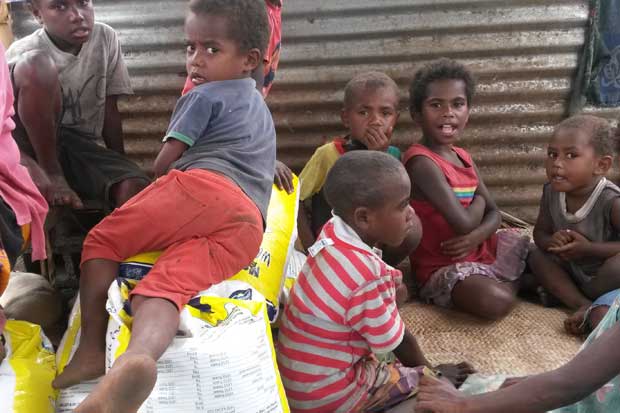
Uncle Simil later tells me he is telling people to start planting again.
“In the village, start planting now. Get the seeds of the bananas that have fallen. Plant it in a big area, maybe for the community and then individual families. We have to advance the program, we have to put in a strategy.”
Oleman Johnson tells me they will start planting. The kamala won’t be ready to harvest for at least three months, but island cabbage is quick, it only takes a month to grow.
They need these seeds.
“It’s not a western way of living,” Uncle Simil tells me before we leave.
“Even if the government wasn’t there, even if there was no aid, we would still have help.
“We have a system of helping each other that is very strong. It is inbuilt. It is very unique to Vanuatu.”
* Amy McQuire is a senior reporter for New Matilda. She’ll be filing from Vanuatu for the next week. You can help support this sort of journalism by clicking here and subscribing to New Matilda.
Donate To New Matilda
New Matilda is a small, independent media outlet. We survive through reader contributions, and never losing a lawsuit. If you got something from this article, giving something back helps us to continue speaking truth to power. Every little bit counts.




